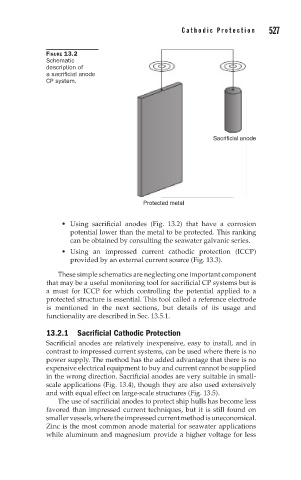Page 564 - Corrosion Engineering Principles and Practice
P. 564
526 C h a p t e r 1 3 C a t h o d i c P r o t e c t i o n 527
FIGURE 13.2
Schematic
description of
a sacrificial anode
CP system.
Sacrificial anode
Protected metal
• Using sacrificial anodes (Fig. 13.2) that have a corrosion
potential lower than the metal to be protected. This ranking
can be obtained by consulting the seawater galvanic series.
• Using an impressed current cathodic protection (ICCP)
provided by an external current source (Fig. 13.3).
These simple schematics are neglecting one important component
that may be a useful monitoring tool for sacrificial CP systems but is
a must for ICCP for which controlling the potential applied to a
protected structure is essential. This tool called a reference electrode
is mentioned in the next sections, but details of its usage and
functionality are described in Sec. 13.5.1.
13.2.1 Sacrificial Cathodic Protection
Sacrificial anodes are relatively inexpensive, easy to install, and in
contrast to impressed current systems, can be used where there is no
power supply. The method has the added advantage that there is no
expensive electrical equipment to buy and current cannot be supplied
in the wrong direction. Sacrificial anodes are very suitable in small-
scale applications (Fig. 13.4), though they are also used extensively
and with equal effect on large-scale structures (Fig. 13.5).
The use of sacrificial anodes to protect ship hulls has become less
favored than impressed current techniques, but it is still found on
smaller vessels, where the impressed current method is uneconomical.
Zinc is the most common anode material for seawater applications
while aluminum and magnesium provide a higher voltage for less

